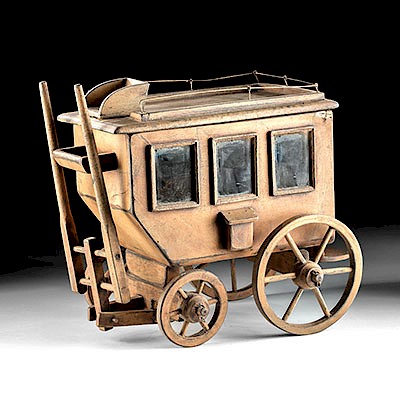Olmec Stone Manopla from Ballgame - Caterpillar Form
Lot 12
About Seller
Artemis Fine Arts
686 S Taylor Ave, Ste 106
Louisville, CO 80027
United States
Selling antiquities, ancient and ethnographic art online since 1993, Artemis Gallery specializes in Classical Antiquities (Egyptian, Greek, Roman, Near Eastern), Asian, Pre-Columbian, African / Tribal / Oceanographic art. Our extensive inventory includes pottery, stone, metal, wood, glass and textil...Read more
Estimate:
$5,000 - $8,000
Absentee vs Live bid
Two ways to bid:
- Leave a max absentee bid and the platform will bid on your behalf up to your maximum bid during the live auction.
- Bid live during the auction and your bids will be submitted real-time to the auctioneer.
Bid Increments
| Price | Bid Increment |
|---|---|
| $0 | $25 |
| $300 | $50 |
| $1,000 | $100 |
| $2,000 | $250 |
| $5,000 | $500 |
| $10,000 | $1,000 |
| $20,000 | $2,500 |
| $50,000 | $5,000 |
| $100,000 | $10,000 |
| $200,000 | $20,000 |
About Auction
By Artemis Fine Arts
Nov 14, 2019
Set Reminder
2019-11-14 10:00:00
2019-11-14 10:00:00
America/New_York
Bidsquare
Bidsquare : Ethnographic | Tribal | American Frontier
https://www.bidsquare.com/auctions/artemis-gallery/ethnographic-tribal-american-frontier-4634
Featuring Pre-Columbian, Tribal / Oceanic, Spanish Colonial, historical examples from the Spanish, Mexican, and American frontiers, fossils, and more. All items offered for sale have been legally acquired, are legal to sell and are guaranteed to be as described or your money back. Artemis Fine Arts info@artemisgallery.com
Featuring Pre-Columbian, Tribal / Oceanic, Spanish Colonial, historical examples from the Spanish, Mexican, and American frontiers, fossils, and more. All items offered for sale have been legally acquired, are legal to sell and are guaranteed to be as described or your money back. Artemis Fine Arts info@artemisgallery.com
- Lot Description
Pre-Columbian, Mexico, Olmec culture, ca. 6th to 3rd century BCE. A manopla, a fascinating and rare stone artifact from the ball game, with a semicircle form, a thick columnar handle through its open center, and a relief image of a caterpillar carved onto the exterior of its curved face. It is made from pale grey volcanic stone. Manoplas were used to strike the heavy rubber ball in some versions of the ballgame, and they are found alongside yokes, hachas, and palmas. They originated in central Veracruz and then spread throughout Olmec territory, ultimately being used in the Yucatan and highland Guatemala. They are sometimes known as padlock stones. The caterpillar has two round, disc-like, bulging eyes and a symmetrical zigzag form along its back. Size: 13.5" W x 6.75" H (34.3 cm x 17.1 cm); 9.25" H (23.5 cm) on included custom stand.
The symbolism of the caterpillar is fascinating. Many Mesoamerican cultures believed that meteors became caterpillars when they struck the earth. The people of Teotihuacan and the Aztecs also associated caterpillars with the bundles in which they burned warriors' bodies, whose souls became butterflies in death. The Maya, meanwhile, seem to have used caterpillars to symbolize birth. The common theme is transformation, which must have been an important belief for the ancient person who commissioned this piece.
Provenance: private Hawaii, USA collection; ex-Peter Wray collection
All items legal to buy/sell under U.S. Statute covering cultural patrimony Code 2600, CHAPTER 14, and are guaranteed to be as described or your money back.
A Certificate of Authenticity will accompany all winning bids.
We ship worldwide and handle all shipping in-house for your convenience.
#145391One side has been repaired from several large pieces. Repairs are well done and unobtrusive. The stone is weathered, with some small losses, mainly from the peripheries, and a slightly larger loss from the bottom edge. Otherwise nice preservation of form.Condition
- Shipping Info
-
All shipping is handled in-house for your convenience. Your invoice from Artemis Gallery will include shipping calculation instructions. If in doubt, please inquire BEFORE bidding for estimated shipping costs for individual items.
-
- Buyer's Premium



 EUR
EUR CAD
CAD AUD
AUD GBP
GBP MXN
MXN HKD
HKD CNY
CNY MYR
MYR SEK
SEK SGD
SGD CHF
CHF THB
THB













